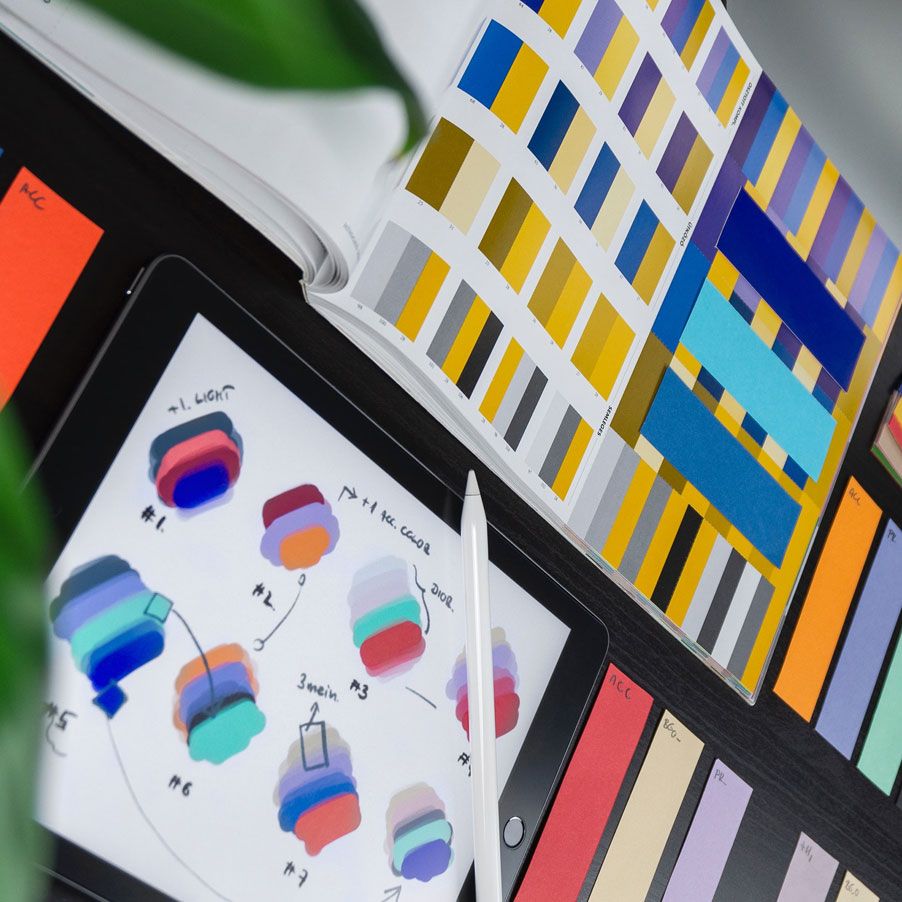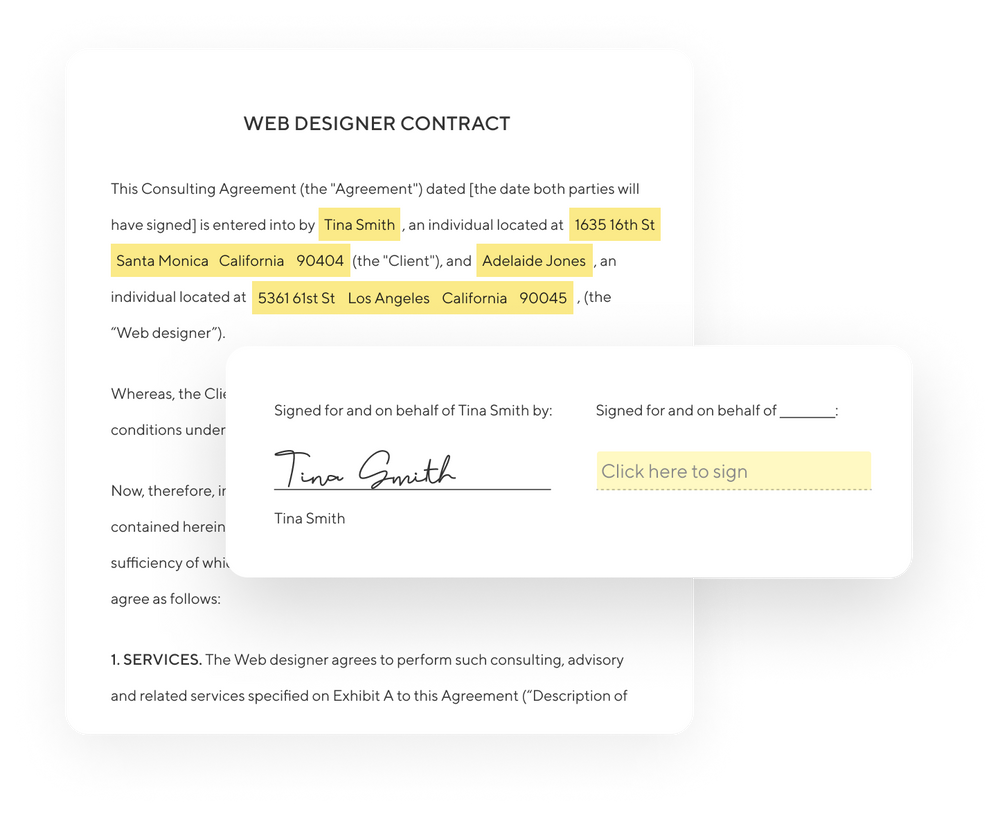Whether you're just starting out in graphic design or you're an experienced designer hoping to become a full- or part-time freelancer, navigating the graphic design industry can be a challenge. This guide is designed to help introduce you to the world of graphic design by describing what graphic designers do and explaining what qualifications they need, diving into the pros and cons, and answering some common questions about the current state of the graphic design industry.
With this information under your belt and a little bit of hard work, there's no limit to what you can accomplish as a freelance graphic designer.
What Do Graphic Designers Do?
Simply put, graphic designers create visual concepts for brands that they can use to communicate ideas to their consumers. In practice, this might translate into designing a logo or developing a brand identity for a company, selecting colors and typefaces to create a coherent web design, or generating designs for brochures or pamphlets.
Because graphic designers work with both text and images, they need to be able to incorporate both into their designs. They must also be able to generate designs for a wide variety of media, including social media, in order to establish a strong and clear brand identity.
A significant number of graphic designers are freelancers, with labor statistics indicating that 21% of graphic designers in the US in 2019 identified as being self-employed. The median wage for graphic designers in May 2019 was $52,110. Some similar occupations to graphic designers include art directors and fine artists.
These statistics prove one main point: if the idea of freelancing your way to success as a graphic designer intrigues you, you're not alone!
How Does One Become A Graphic Designer?
Becoming a graphic designer often requires some formal training, as a bachelor's degree in graphic design is sometimes required, although an increasing number of designers are self-taught too. To strengthen their artistic skills, designers should take art and design classes, as well as courses in additional skills such as web design and printing techniques.
Furthermore, many colleges and universities offer classes in marketing and business, which are valuable skills for any graphic designer to possess. Competitive graphic designers are also well-versed in using a variety of computer programs, such as Illustrator, Photoshop, and more.
The most important qualification that a graphic designer must have is a portfolio, which is a collection of that designer's work. Having a strong portfolio allows potential clients to see whether your aesthetic might be a good fit for them. It also demonstrates that you have the skills and experience you need to do the type of work that they're hoping to accomplish. Having a great portfolio that shows off your skills and style is a great way to break into the field of graphic design and start landing your first few clients.
The Pros and Cons of Becoming a Freelance Graphic Designer
Being a freelance graphic designer might sound like a dream -- you get to create your own hours, be your own boss, and work on projects you’re passionate about. Who wouldn’t want that?
I’m here to tell you there’s more to it than just doing the work you love. When you freelance, you become your own business. As with any business, there are always pros and cons.
If you’re a graphic designer deciding whether to take the leap into the freelance world, these are some of the major pitfalls and the major perks that come with working as a freelancer.
The Cons
You Are Your Own Business
Since you’re the business, you are also the HR, billing, and marketing departments. You assume every role of the business. Some graphic designers might not be prepared for all the responsibilities that come with this.
If you get behind on your billing, that means no pay that month. It’s important to stay on top of everything while continuing to produce high-quality work that clients love.
It’s a huge amount of responsibility for one person to take on. With a normal business, there would be trained professionals to take care of each individual role, but with freelancing, everything is in your hands.
Not Working the Typical 9-5 Doesn’t Mean Fewer Hours
This is a common misconception. Even if you’re not working the typical 9-5, that doesn’t mean you won’t still be working 40 hours or more a week. This is especially true when you’re just starting out.
So what does the life of a graphic designer look like? Be prepared to work long hours and give up personal time. If you’re trying to meet a deadline or send an invoice, that could mean some long nights or early mornings. Many times, even if you’re working sporadic hours, you’ll end up working more than just 40 hours a week.
Remember, you can always use a management platform or software, like Indy, to help keep track of all those small details if it becomes too much to handle on your own.
Sometimes Too Many Assignments, Sometimes Too Few
Sometimes you’ll be raking in the big bucks, other times you’ll barely be getting by. This is just a necessary evil in the freelancing world -- there’s no certainty.
Even if you have three clients one day, all three of those clients could be gone the next. We’re not saying this will happen, but it’s important to be prepared for this possibility.
Doing the work you love comes with the price of never knowing when that work might disappear. Be sure you’re able to accept this reality.
The Pros
You Make Your Own Schedule
This is honestly one of the best parts about being a freelancer. There is no set schedule.
If you need to care for a relative or have a young child, you have the freedom to take care of them in the morning and do your work at night. No other job allows for this kind of flexibility.
This freedom means you can decide not to work a full day if you’re having an “off day” or need a break. As long as you’re completing your projects on time and meeting client expectations, your time is your own. Now that’s a beautiful thing!
You’re Not Tied to an Office Desk
Another beautiful part of freelancing is that there is no “set” workspace or office. As a graphic designer, you’re probably a very creative soul. Maybe this means you might do your best work while sitting outside in a park or by the beach listening to the waves.
This usually wouldn’t be a possibility with a typical 9-5 job, but freelancing allows you the freedom to work wherever you want. So much freedom means you can find a place to work that’s best suited to your creativity.
You Choose Your Own Clients
This might not always be true, especially when you’re first starting out. Sometimes you might need to take on clients to make ends meet, but as you continue establishing yourself as a freelance graphic designer, you’ll be able to choose who you work with.
If you have a meeting with a potential client and it doesn’t feel like a good fit, you’re under no obligation to work with them. At a typical graphic design job, you can’t say no to work that comes across your desk. That’s part of your job, but as a freelancer, you have the final say. If something doesn’t feel right or there’s no fulfillment in a proposed project, you don’t need to take it.
Is The Graphic Design Career Over-Saturated?
A commonly held belief is that the graphic design industry is over-saturated or even that graphic design is dead. This belief is likely due to the recent rise of a wide variety of online services offering fast and cheap graphic design services, such as those that provide clients with $5 logos or rapid and inexpensive website design.
However, although the number of graphic designers has increased, so has the demand for good graphic design. Labor statistics indicate that the employment of graphic designers is expected to decrease by 4% from 2019 to 2029, but they also suggest that these statistics are field-specific: although newspapers and periodicals are expected to hire fewer designers, the demand for graphic designers in the world of web design and online-specific design is expected to grow.
Overall, the field of graphic design is still an active one. In 2019, the graphic design industry generated $15 billion in revenue, indicating that there is still a need for high-quality graphic designers. Additionally, although the rise of fast and cheap graphic design has been meteoric, many companies still prefer to hire skilled designers who can create a cohesive brand identity that can appeal to consumers online, across social media, and in person.
In summary, although competition may be increasing, there are still plenty of opportunities for strong graphic designers with up-to-date skills and a great work ethic to find clients.
How Can One Succeed As A Graphic Designer?
Becoming a graphic designer requires more than just artistic prowess. All freelancers need excellent time management skills, the ability to multitask on multiple clients' projects at once, and excellent communication skills, which can help you explain ideas to your clients as well as to consumers through your work.
More specifically, graphic designers must understand the basics of typography, coding, and branding. If you're a creative person who is self-motivated, driven, and enthusiastic about creating art that is meant to engage consumers, then you're well on your way to becoming a successful graphic designer. Plus, there are many online platforms that can make your work easier such as Envato Elements and its extensive library of creative digital assets.
However, freelance graphic designers face additional hurdles when trying to succeed in the graphic design industry. Because freelancers are small business owners, they are responsible for generating their own retainer contracts, invoicing clients for their design work, and tracking their hours.
Freelance tools such as Indy are invaluable resources for helping freelancers better manage their time, clients, and efficiency by offering forms and other tools that can help you run the administrative side of your freelance business more smoothly. If you're confident about your design skills but not so sure about your ability to transform into a business whiz overnight, a tool like this may be the perfect option for you.
Launching or Building Your Freelance Graphic Design Career
The world of graphic design is an exciting creative field that is full of possibilities. As long as you have the proper education and skill set needed to become a graphic designer, the sky's the limit when it comes to applying your talents.
Whether you're more excited about dreaming up a new web design or generating a cohesive brand identity for a corporation, all graphic designers are skilled at using words and art to communicate their messages to consumers. If you're interested in becoming a full- or part-time graphic designer, why not get started on generating a portfolio today? You might be surprised by what you end up creating.




